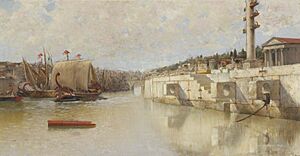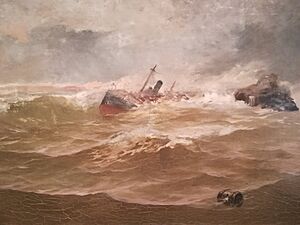Justo Ruiz Luna facts for kids
Justo Ruiz Luna (born 1865 in Cádiz, Spain; died 9 March 1926 in Cádiz) was a Spanish artist. He was a painter, and he also worked with watercolors and pastels. He is most famous for his beautiful paintings of the sea and ships.
Contents
Early Life and Art Studies
Justo Ruiz Luna came from a well-off family. Before becoming an artist, he studied business. But his true passion was art.
From 1882 to 1884, he studied at the Real Academia Provincial de Bellas Artes in Cádiz. There, he learned from a teacher named Joaquín Damis y Cortés.
He also spent time in Rome, Italy, which was a very important place for artists. He met many other Spanish artists studying there. Later, he went back to Rome with his friend, Salvador Viniegra. They worked with a famous artist named José Villegas Cordero. Villegas had a big impact on Justo Ruiz Luna's painting style. Justo Ruiz Luna loved Rome and visited it many times throughout his life.
Exhibitions and Famous Paintings
Justo Ruiz Luna quickly started showing his art to the public.
- In 1886, he and other students of José Villegas Cordero had an art show in Madrid.
- In 1887, he entered the National Exhibition of Fine Arts (Spain) with a painting of a shipwreck. He received an honorable mention for it.
- In 1888, he sent another shipwreck painting to the 1888 Barcelona Universal Exposition. He also sent a painting called "Ostia" to an art show in Munich, Germany.
His hard work paid off! In 1890, he won a First Class prize at the National Exhibition for his painting of the Battle of Trafalgar. This was a very important battle at sea.
Working and Painting
Soon after his big win in 1890, Justo Ruiz Luna took a job as an inspector for a shipping company called Compañía Transatlántica Española. This job meant he couldn't travel to Italy as much. He also couldn't paint every day. However, he still created many small watercolor and pastel pictures of the company's ships.
In 1890, the Academia de Bellas Artes in Cádiz made him a member. But he didn't take on any official duties there.
By 1892, he had enough new paintings to enter another exhibition in Munich. He won a Second Class medal! He also showed ten works at the National Exhibition that year. One of his large paintings, "October 1492," won a bronze medal the next year at the World's Columbian Exposition in Chicago, USA. In 1895, he showed more paintings at the National Exhibition, including one of the "Battle of Lepanto."
Later Life
In 1901, Justo Ruiz Luna was able to return to Rome for a few months. There, he created a series of pastel drawings of famous historical places.
In 1907, he became an assistant teacher for art classes at the Escuela de Artes Industriales in Cádiz. He then left his job at the shipping company.
Around 1910, he sadly lost an eye. Even though this was a big challenge, he kept painting. However, his later paintings became simpler, and his colors were not as bright as before.
See also
 In Spanish: Justo Ruiz Luna para niños
In Spanish: Justo Ruiz Luna para niños



